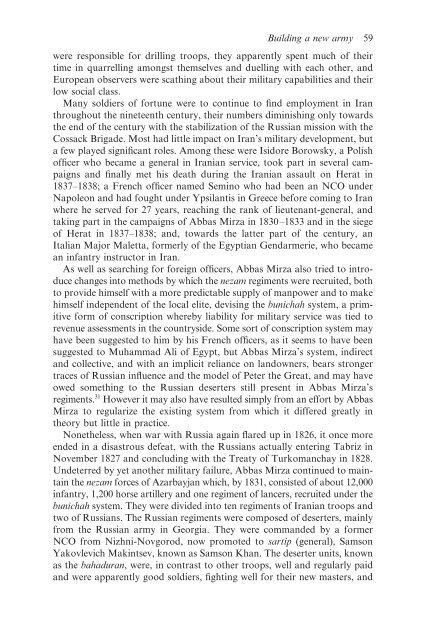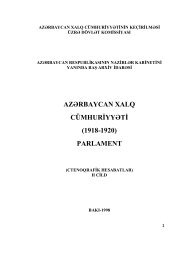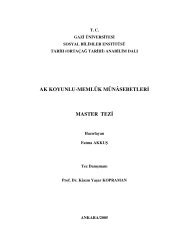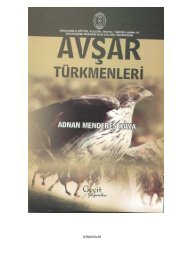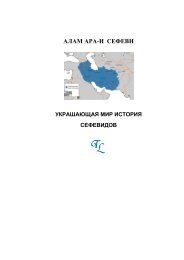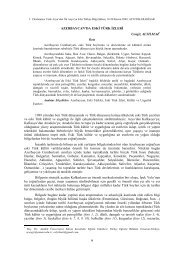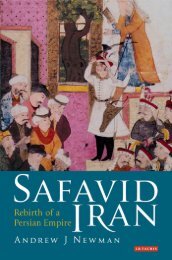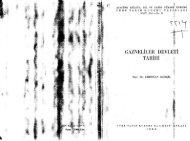War and Peace in Qajar Persia: Implications Past and ... - Oguzlar.az
War and Peace in Qajar Persia: Implications Past and ... - Oguzlar.az
War and Peace in Qajar Persia: Implications Past and ... - Oguzlar.az
- No tags were found...
You also want an ePaper? Increase the reach of your titles
YUMPU automatically turns print PDFs into web optimized ePapers that Google loves.
Build<strong>in</strong>g a new army 59were responsible for drill<strong>in</strong>g troops, they apparently spent much of theirtime <strong>in</strong> quarrell<strong>in</strong>g amongst themselves <strong>and</strong> duell<strong>in</strong>g with each other, <strong>and</strong>European observers were scath<strong>in</strong>g about their military capabilities <strong>and</strong> theirlow social class.Many soldiers of fortune were to cont<strong>in</strong>ue to f<strong>in</strong>d employment <strong>in</strong> Iranthroughout the n<strong>in</strong>eteenth century, their numbers dim<strong>in</strong>ish<strong>in</strong>g only towardsthe end of the century with the stabilization of the Russian mission with theCossack Brigade. Most had little impact on Iran’s military development, buta few played significant roles. Among these were Isidore Borowsky, a Polishofficer who became a general <strong>in</strong> Iranian service, took part <strong>in</strong> several campaigns<strong>and</strong> f<strong>in</strong>ally met his death dur<strong>in</strong>g the Iranian assault on Herat <strong>in</strong>1837–1838; a French officer named Sem<strong>in</strong>o who had been an NCO underNapoleon <strong>and</strong> had fought under Ypsilantis <strong>in</strong> Greece before com<strong>in</strong>g to Iranwhere he served for 27 years, reach<strong>in</strong>g the rank of lieutenant-general, <strong>and</strong>tak<strong>in</strong>g part <strong>in</strong> the campaigns of Abbas Mirza <strong>in</strong> 1830–1833 <strong>and</strong> <strong>in</strong> the siegeof Herat <strong>in</strong> 1837–1838; <strong>and</strong>, towards the latter part of the century, anItalian Major Maletta, formerly of the Egyptian Gendarmerie, who becamean <strong>in</strong>fantry <strong>in</strong>structor <strong>in</strong> Iran.As well as search<strong>in</strong>g for foreign officers, Abbas Mirza also tried to <strong>in</strong>troducechanges <strong>in</strong>to methods by which the nezam regiments were recruited, bothto provide himself with a more predictable supply of manpower <strong>and</strong> to makehimself <strong>in</strong>dependent of the local elite, devis<strong>in</strong>g the bunichah system, a primitiveform of conscription whereby liability for military service was tied torevenue assessments <strong>in</strong> the countryside. Some sort of conscription system mayhave been suggested to him by his French officers, as it seems to have beensuggested to Muhammad Ali of Egypt, but Abbas Mirza’s system, <strong>in</strong>direct<strong>and</strong> collective, <strong>and</strong> with an implicit reliance on l<strong>and</strong>owners, bears strongertraces of Russian <strong>in</strong>fluence <strong>and</strong> the model of Peter the Great, <strong>and</strong> may haveowed someth<strong>in</strong>g to the Russian deserters still present <strong>in</strong> Abbas Mirza’sregiments. 31 However it may also have resulted simply from an effort by AbbasMirza to regularize the exist<strong>in</strong>g system from which it differed greatly <strong>in</strong>theory but little <strong>in</strong> practice.Nonetheless, when war with Russia aga<strong>in</strong> flared up <strong>in</strong> 1826, it once moreended <strong>in</strong> a disastrous defeat, with the Russians actually enter<strong>in</strong>g Tabriz <strong>in</strong>November 1827 <strong>and</strong> conclud<strong>in</strong>g with the Treaty of Turkomanchay <strong>in</strong> 1828.Undeterred by yet another military failure, Abbas Mirza cont<strong>in</strong>ued to ma<strong>in</strong>ta<strong>in</strong>the nezam forces of Azarbayjan which, by 1831, consisted of about 12,000<strong>in</strong>fantry, 1,200 horse artillery <strong>and</strong> one regiment of lancers, recruited under thebunichah system. They were divided <strong>in</strong>to ten regiments of Iranian troops <strong>and</strong>two of Russians. The Russian regiments were composed of deserters, ma<strong>in</strong>lyfrom the Russian army <strong>in</strong> Georgia. They were comm<strong>and</strong>ed by a formerNCO from Nizhni-Novgorod, now promoted to sartip (general), SamsonYakovlevich Mak<strong>in</strong>tsev, known as Samson Khan. The deserter units, knownas the bahaduran, were, <strong>in</strong> contrast to other troops, well <strong>and</strong> regularly paid<strong>and</strong> were apparently good soldiers, fight<strong>in</strong>g well for their new masters, <strong>and</strong>


